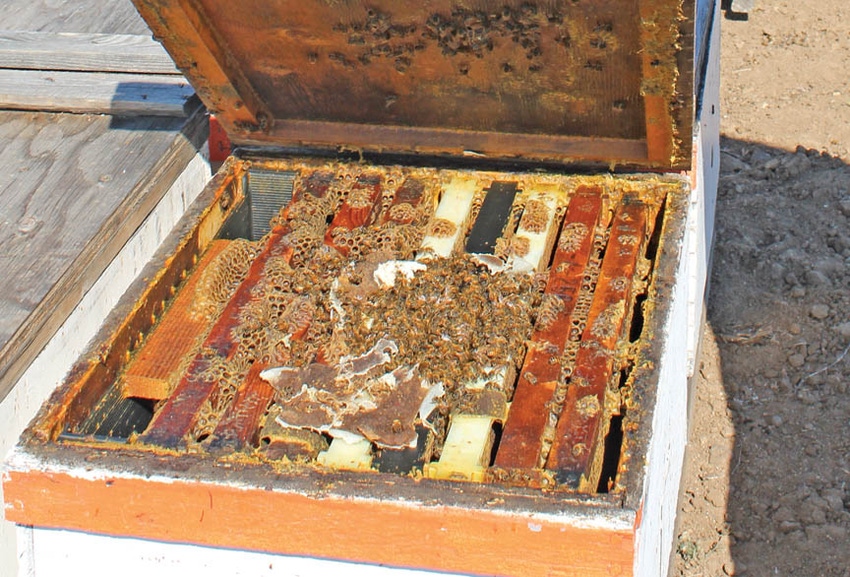
Bee supply better for 2012 almond pollination
Nearly 1 million bee hives are trucked into California each winter for pollination services for the state’s multi-million dollar almond industry. As the nation’s No. 1 producer of almonds, California has more than 750,000 acres of bearing almonds and needs two strong colonies per acre to achieve proper pollination.Terra Bella beekeeper Jack Brumley agreed that bee losses are not as devastating as they have been in past years, but still are around 25 percent.

It’s not perfect this year, but it’s better.
That sums up the observations of bee expert Eric Mussen and California beekeepers on the state of honey bee strength for the 2012 almond pollination season.
Truckloads of bees from nearly every state begin arriving in California’s Central Valley in late December in preparation for almond pollination starting last month.
Nearly 1 million hives are trucked into California each winter for pollination services for the state’s multi-million dollar almond industry. As the nation’s No. 1 producer of almonds, California has more than 750,000 acres of bearing almonds and needs two strong colonies per acre to achieve proper pollination. California beekeepers supply the remaining half million hives needed.
“Growers want the strongest possible hives, and we offer them a look at the inside of the hives when we deliver,” said Gene Brandi, a Los Banos beekeeper who is active in state and national beekeeping associations. Brandi added that he has not heard of too many major crashes in honey bee hives recently — a change from a few years ago when talk of colony collapse disorder caused great concern among growers.
Mussen, a UC Extension apiculturist, said 2012 hive strength has improved over the last few years, and attributes stronger hives to beekeepers who have found ways to overcome losses.
Beginning in October 2006, beekeepers began reporting huge losses in bee numbers for unknown reasons. Without a specific cause for the losses, the term colony collapse disorder was coined. According to the USDA’s Agricultural Research Service, colony collapse disorder does not have a recognizable underlying cause, but is a result of a number of factors including viruses, parasites and environmental stresses.
Since that time, Mussen said, beekeepers have found ways to improve hive health and strength. Last year’s above average rainfall in California also provided a higher level of nutrition for foraging honey bees. Mussen said that added nutrition could make a significant difference in honey bee health.
Beekeepers have found that while first year colonies of bees are generally strong, they can be hit with health problems in the second year. Splitting the colonies and redistributing them can help them build back strength or “outrun” problems, Mussen said.
Bee losses still mounting
Terra Bella beekeeper Jack Brumley agreed that bee losses are not as devastating as they have been in past years, but still are around 25 percent. He noted that one out-of-state beekeeper lost more than half his bees since they were trucked into California in December.
Shannon Mueller, a UC Cooperative Extension farm advisor in Fresno County, said there has been an increase in requests by almond growers for beehive strength evaluations recently due to concerns about colony collapse disorder. The person requesting the inspection pays the county for the service which ensures almond growers get what they pay for.
The evaluations are good for the grower as well as the beekeeper, said Mueller. The independent inspections by the county determines the strength and value of the hive. Growers pay about $150 per colony for pollination services.
County inspectors select a set of hives and open the centers to count the number of frames that are covered with bees. Eight covered frames are average, and mean plenty of bees will be out foraging and covering more trees per day. Mueller cautioned that two hives with four frames each do not add up to the strength of an eight-frame hive.
Brandi said some growers specify an eight-frame minimum and will pay higher rates.
He said a California State Beekeeper Association survey found that growers are paying slightly more this year per hive.
While the bees make money for pollination, beekeepers also depend on their honey production. The dry winter weather means there will be less native forage — wildflowers and other pollen sources — for honey bees. Out-of-state bees usually stay for the citrus bloom before the bees are trucked back home.
Dave Baker, director of member services for Blue Diamond, said that while the industry has about 100,000 new acres bearing this year, they do not expect to have any problems pollinating the 2012 crop.
“From what I’ve been hearing they will all be covered,” he said.
“Every year is different with almond tree strength. Last year we had a strong nonpareil bloom. We’ll wait and see what the trees to this year. Bud set looks a little weaker right now.”
About the Author(s)
You May Also Like



